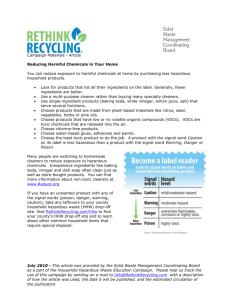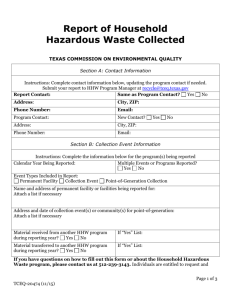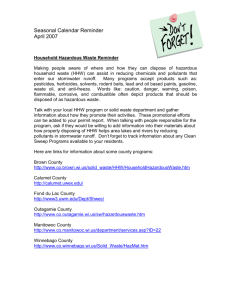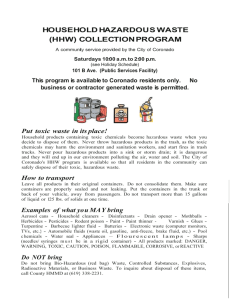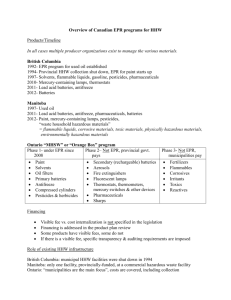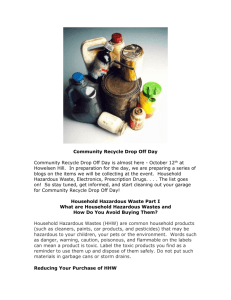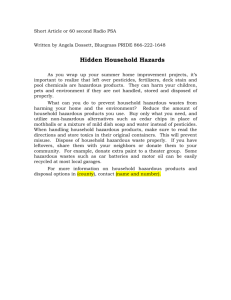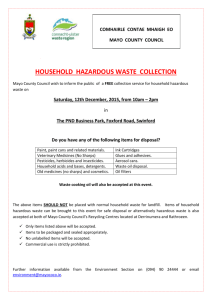Household Products
advertisement
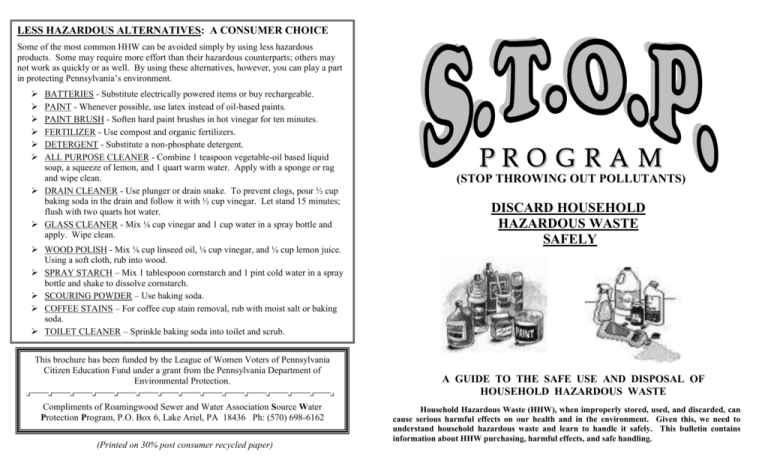
LESS HAZARDOUS ALTERNATIVES: A CONSUMER CHOICE Some of the most common HHW can be avoided simply by using less hazardous products. Some may require more effort than their hazardous counterparts; others may not work as quickly or as well. By using these alternatives, however, you can play a part in protecting Pennsylvania’s environment. BATTERIES - Substitute electrically powered items or buy rechargeable. PAINT - Whenever possible, use latex instead of oil-based paints. PAINT BRUSH - Soften hard paint brushes in hot vinegar for ten minutes. FERTILIZER - Use compost and organic fertilizers. DETERGENT - Substitute a non-phosphate detergent. ALL PURPOSE CLEANER - Combine 1 teaspoon vegetable-oil based liquid soap, a squeeze of lemon, and 1 quart warm water. Apply with a sponge or rag and wipe clean. DRAIN CLEANER - Use plunger or drain snake. To prevent clogs, pour ½ cup baking soda in the drain and follow it with ½ cup vinegar. Let stand 15 minutes; flush with two quarts hot water. GLASS CLEANER - Mix ⅛ cup vinegar and 1 cup water in a spray bottle and apply. Wipe clean. WOOD POLISH - Mix ⅛ cup linseed oil, ⅛ cup vinegar, and ¼ cup lemon juice. Using a soft cloth, rub into wood. SPRAY STARCH – Mix 1 tablespoon cornstarch and 1 pint cold water in a spray bottle and shake to dissolve cornstarch. SCOURING POWDER – Use baking soda. COFFEE STAINS – For coffee cup stain removal, rub with moist salt or baking soda. TOILET CLEANER – Sprinkle baking soda into toilet and scrub. This brochure has been funded by the League of Women Voters of Pennsylvania Citizen Education Fund under a grant from the Pennsylvania Department of Environmental Protection. Compliments of Roamingwood Sewer and Water Association Source Water Protection Program, P.O. Box 6, Lake Ariel, PA 18436 Ph: (570) 698-6162 (Printed on 30% post consumer recycled paper) (STOP THROWING OUT POLLUTANTS) DISCARD HOUSEHOLD HAZARDOUS WASTE SAFELY A GUIDE TO THE SAFE USE AND DISPOSAL OF HOUSEHOLD HAZARDOUS WASTE Household Hazardous Waste (HHW), when improperly stored, used, and discarded, can cause serious harmful effects on our health and in the environment. Given this, we need to understand household hazardous waste and learn to handle it safely. This bulletin contains information about HHW purchasing, harmful effects, and safe handling. EFFECTS OF HHW HOW TO RECOGNIZE HHW Household Hazardous Waste comes in solid, liquid, and gaseous form. It may be one or more of the following: CORROSIVE TOXIC (POISONOUS) REACTIVE FLAMMABLE VOLATILE EXPLOSIVE All HHW has the potential to harm human health and contaminate the environment when improperly used and discarded. Depending on the composition and characteristics, HHW may damage the skin, eyes, lungs, nervous system and such internal organs as the liver and kidneys. The effect may be acute (immediate) or chronic (long-term). Improper use and disposal of HHW will contaminate ground and surface waters, injure or kill wildlife and aquatic life, and contaminate the indoor and outdoor atmosphere. The label on containers of hazardous household products may carry the word and/or a symbol if the contents have any of these characteristics. If they appear on the label, then the product is “hazardous”. EXAMPLES OF HHW There are hundreds of household products that can be harmful. The following are common examples: SUGGESTIONS FOR HHW SAFETY PURCHASING Always read the label before purchasing household products. Never purchase more than you can use in a short time. Purchase the least hazardous product that will serve your purpose. STORING Note: Not all collection facilities accept these products, so please call them for details. Household Products DRAIN CLEANERS OVEN CLEANERS SILVER POLISH OIL BASE PAINTS LEAD BASE PAINTS STAINS AND VARNISHES PAINT STRIPPERS TURPENTINE AND THINNERS ADHESIVES WOOD PRESERVATIVES DRIVEWAY SEALERS TOILET BOWL CLEANERS DISINFECTANTS MOTHBALLS BATHROOM CLEANERS CARPET CLEANERS SPOT REMOVERS ROOM DEODORIZERS DRY CLEANING FLUIDS FURNITURE POLISH Lawn and Garden Products PESTICIDES HERBICIDES FUNGICIDES RODENTICIDES INSECTICIDES Automotive Products WASTE OIL* ANTIFREEZE CARBURETOR CLEANERS OIL ADDITIVES AUTOMOBILE BATTERIES A/C REFRIGERANTS WAXES AND POLISHES AUTO BODY PUTTY TRANSMISSION FLUID STARTER FLUID Other Products SWIMMING POOL CHEMICALS LIGHTER FLUID PHOTOGRAPHIC CHEMICALS SOLDER MERCURY SWITCHES BUTTON TYPE BATTERIES RECHARGEABLE BATTERIES FLASHLIGHT BATTERIES MERCURY VAPOR LIGHTS KEROSENE AEROSOL CANS ARTS AND CRAFT SUPPLIES COMPUTERS INK AND TONER CARTRIDGES *Waste oil can be taken to a used oil collection site for disposal or recycling. (One gallon of oil dumped into a surface water body can form a slick up to eight acres in size.) Store containers in a clean, orderly, dry, cool, well ventilated place. Keep HHW out of the reach of children and pets. Do not remove labels. Keep containers tightly sealed. USING Always follow directions printed on the label. Keep children and pets away when using hazardous products. Ensure work area is well ventilated. Keep products away from open flame. Don’t use more of the product than is recommended. Never mix products together unless indicated in the directions. DISCARDING Do not discard products or partially filled containers with the garbage. Do not pour leftover products into the sewage system or storm water drain. Share leftover products with others who can properly use the product. Do not remove products from their original container and do not remove labels. Wrap each container in a plastic bag, seal tightly, and store in a clean, dry, cool place until time of transport to a collection facility.
